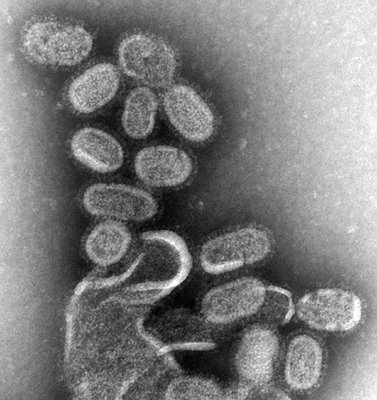
Bird flu: A beginner's guide, to quell panic
Why is flu in birds suddenly such a problem? Headlines, newscasts, and documentaries flood us with news of developments. What does it all mean? Where did it come from and where is it going?
Terminology we have not seen before, like "H5N1", "clusters", "genetic drift and shift", "zoonosis", "pandemic" and others get thrown around as if plainly understood. Getting a grasp of the problem and the risks, and thus putting breaking news into context, requires some understanding of virus biology.
Without it, we are at the mercy of irrational fear and the dire consequences of panic in the face of what is likely to be a relatively minor threat.
Contributor J Kevin Baird offers a "road map" for the uninitiated to navigate through the quagmire of misunderstanding:
How a virus works
The chemical code of life is deoxyribonucleic acid (DNA). All living things possess their own unique code, expressed in the sequence of just four different chemicals.
Some evolutionary biologists view all forms of life as simply representations of a survival strategy by a particular collection of these four chemicals. This view holds, for example, that the being we see as a horse is an instrument constructed around horse DNA that allows the molecule to survive.
No living things express this minimalist concept more plainly than viruses. Viruses represent the simplest form of what can be considered a living thing. They are bundled packages of DNA or its complementary chemical partner, RNA (as with influenza).
The bundles of proteins and other biological molecules surrounding the genetic material provide the virus a means of getting into a particular kind of cell it favors, so HIV favors immune cells and hepatitis virus favors liver cells, etc.
Once inside the target cell, the genetic code of the virus inserts itself into genetic material of the cell and issues instructions to the cell to make thousands of copies of the virus. The hijacked and doomed host cell bursts, releasing new viruses to infect new cells.
Balancing act
This form of parasitism is a tricky business for the virus. If all viruses were completely successful, there would be no life left in which to continue their existence. A virus that asserts itself too powerfully will eventually kill off the beings it depends upon to live.
It must show some restraint or perish. Conversely, the virus must also deal with a host having the equipment to defend itself from such attacks. The host immune system vigorously counterattacks, and a lack of assertiveness by the virus would be its doom.
The virus must strike a working balance between successful copying and coping with a provider bent on its destruction. These forces have shaped the viruses into the agents of many diseases we recognize today.
Living evolution
Viruses, like all living things, evolved into the beings present today. Their strategies have been honed and refined by natural selection, the crucible of Darwinian evolution. Viruses that have been with us a long time have adopted various strategies of balance between the harm they cause and the infection absolutely required for their survival.
These viruses tend to be more benign. Their balancing act is a good one. But Nature experiments continuously. New viruses are constantly thrown out, testing the waters of the living world they inhabit. The newer viruses are clumsier and they tend to cause more severe disease.
Viruses are not thinking, strategizing beings. External forces drive their strategizing, where a good strategy results in more copies being made than with a poor strategy.
Think of coconut trees. On the most isolated sandy atoll in Indonesia we see coconut trees standing. How did they get there? Coconuts float. They drop into the sea and off they go, at the mercy of wind, wave and current to find a suitable sandy beach.
A very, very small fraction of them, perchance, actually do. Coconuts do not consult maps and weather forecasts. If one lands on a beautiful sandy beach in Alaska -- and some do -- it is doomed. Most others become waterlogged and sink without ever seeing a beach.
The coconut tree employs a strategy of dumping hundreds of coconuts into the sea and playing the odds that one of them will land at a hospitable site.
Viruses do much the same. They cast themselves out into the living world in their billions playing the odds some of them will find that tropical sandy beach of viruses -- access to the cell they are capable of commandeering.
The nature of bird flu This is what is going on with bird flu. The influenza virus experiments by creating copies with random errors in its genetic code. A very small fraction of those errors will, by chance, yield a virus better equipped to find its sandy tropical beach.
This is called genetic drift. Still other viruses will find themselves in the same host already infected by a related virus strain, and the two of them combine to create many thousands of hybrids with a relatively dramatically different genetic makeup compared to either of the original strains.
Rarely, one of those hybrids will successfully propagate and infect other hosts. This is called genetic shift.
Bird flu is in a group of closely related viruses known as influenza-A. Different strains inhabit the group, much like the races and myriad ethnic groups of humans. The strain designation for bird flu is H5N1, each letter referring to a convenient identity marker found in the envelope enclosing the genetic code of the virus.
Those marker types (the numbers) are specific biological molecules that vary slightly among strains. These variations provide scientists a convenient means of classifying viruses in the influenza-A group, much like we use characteristics of skin color and facial features to determine a person's group identity.
Exactly where H5N1 strain emerged from and how is unclear. It may have been produced by a genetic shift event with the mixing of influenza strains circulating in different bird species. Clearly, the new strain found traction and has been wildly successful.
Its lethality to chickens has not slowed it down, largely because it can infect other species of birds, notably domesticated ducks, and do relatively little harm. Dead chickens simply represent the collateral damage of successes enjoyed elsewhere.
Bird flu in people H5N1 happens to be able to infect people. But the human host does not entirely agree with the virus -- although able to find receptive target cells and replicate itself, the strain finds it very difficult to bridge into a new human host.
Almost all human infections have been in the wake of direct contact with infected chickens, and the few cases of documented transmission from human to human followed close and prolonged contact with an infected person.
A superior influenza-A virus needs no such thing -- it jumps from human to human with great efficiency. This is probably a product of both the infectious dose -- a relatively low number of virus particles needed to successfully seed an infection -- and the inability of the human immune system to defeat the invasion.
H5N1 as it exists today does not possess the equipment to manage this.
Fatality rate with bird flu
The term "case fatality rate" describes the percentage of people exposed to a disease who succumb to it. Scientists do not know the case fatality rate for H5N1 infection. What they do know, and what the media often present as the case fatality rate, is the fatality rate among confirmed infections.
No one knows how many people have been infected by H5N1. We only know how many people have been diagnosed as infected and what happened to them.
The difference between these numbers -- real versus observed infections -- may be very large. People who experience H5N1 infection and an unremarkable illness will not be diagnosed. The reliable diagnosis of H5N1 requires an extraordinarily high degree of technical expertise and very costly equipment and supplies.
The laboratories capable of doing this do not examine people with mild illness. There are not enough machines and money to do so. Consequently, it is very likely that the true case fatality rate for H5N1 infection is very much lower than the more than 50 percent figures often described.
The writer is an expert in tropical infectious diseases who worked formerly with the U.S. Navy as a microbiologist. He was also a section editor for the American Journal of Tropical Medicine & Hygiene. He can be reached at jkb@vhasia.com.sg




















